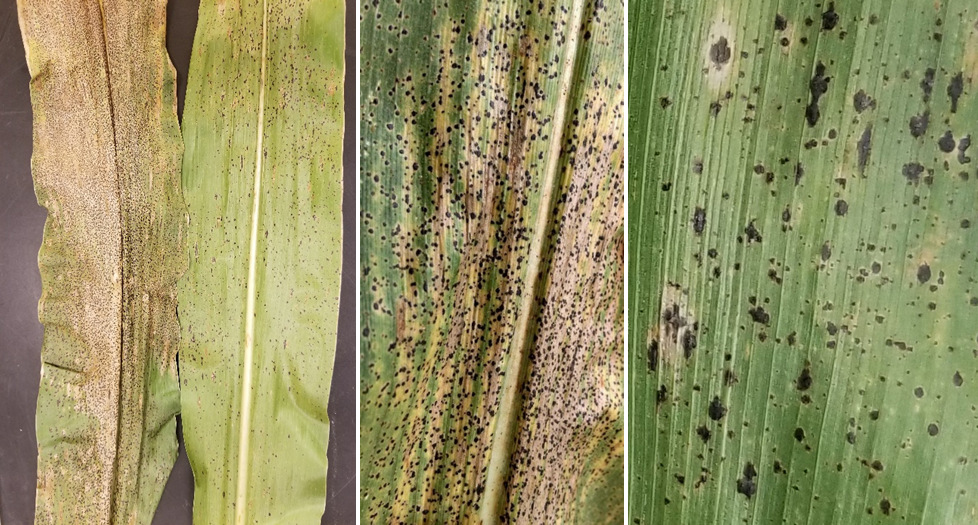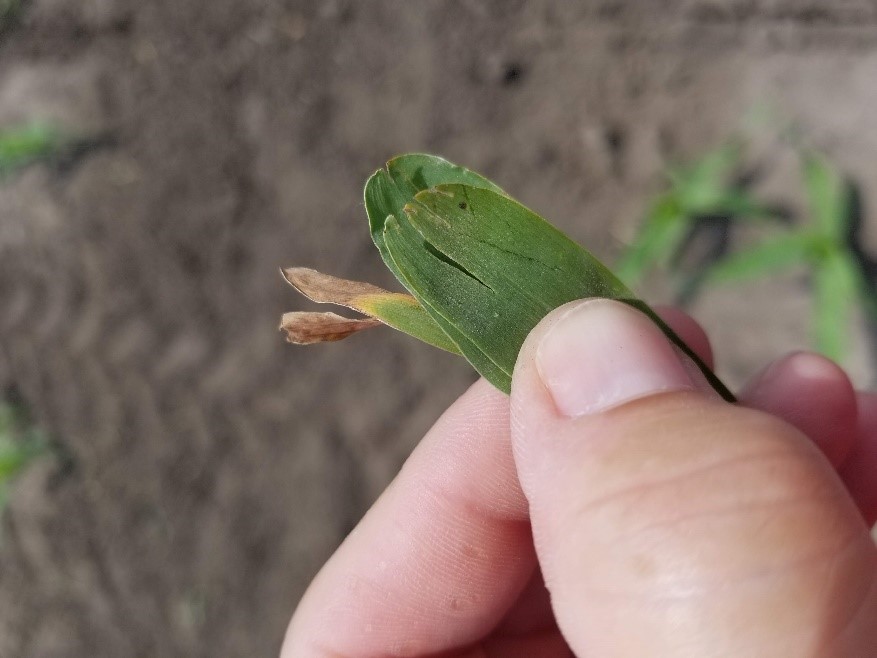Tar spot of corn is a new concern this season after the localized epidemics we experienced last year in Indiana. At this point in the field season, we have not found any active tar spot in corn, but we are on the hunt. We have initiated multiple research projects to try to address the many unanswered questions, but we need your help collecting samples.
WANTED: Corn tar spot samples!
What to look for: Small, black, raised spots (circular or oval) develop on infected plants, and may appear on one or both sides of the leaves, leaf sheaths, and husks. Spots may be found on both healthy (green) and dying (brown) tissue. Often, the black spots are surrounded by a tan or brown halo; this is especially obvious on healthy leaves (see Figure 1).

Figure 1. Corn leaves infected by tar spot. Infection can range from severe to mild on a leaf. The spots will be raised (bumpy to the touch) and will not rub off. In addition, they be surround by a tan or brown halo.
We greatly appreciate the ‘suspect’ samples that we have received this season and want you to keep it up. So far, all of these samples have been false – all insect frass (poop). Therefore, I want to ask before you submit a sample you do a quick and dirty “spit test” to see if you can rub the spot off the leaf, especially if you have leaves with just a few small spots (Figure 2). I have been successful in detecting these false spots by placing a small amount of water (spit) on the leaf and rubbing with my finger – henceforth the “spit-test”. A small drop of water from your water bottle or facet will also do the trick. (Please do not lick your thumb or the leaf since these samples are out in the field and not clean to ingest). This is a quick way to check, but as always if you are unsure send us the sample.

Figure 2. An example where I found a ‘suspect’ spot, but with a little moisture I could rub it off with my finger.
See Figure 3 that shows how we can rub off the ‘suspect’ spot in the lab. Another way to distinguish is to look for insect feeding around the spot – this as well will probably mean you have found insect frass and not tar spot (Figure 3).

Figure 3. A) A ‘Suspect’ tar spot (blue arrow) and insect feeding damage (yellow arrows) on a corn leaf. B) The same spot, but scrapped away red arrows, indicating insect frass. C) A suspect spot on a leaf (green circle), and D) Spot wiped away (green circle). (Photo Credit: John Bonkowski and Tom Creswell, PPDL)
We are working with colleagues across the mid-west to track tar spot. Samples of corn infected with tar spot will greatly assist our on-going research projects investigating the biology and variability of populations of the corn tar spot pathogen.
In addition, we have created a live map that will be updated when we have a positive confirmation. If you are interested, you can follow at this link https://corn.ipmpipe.org/tarspot/ or continue to follow us here, as I will update weekly on the disease progress once we find an active site.
If you have (or think you have) corn tar spot, please collect several leaves showing the symptoms and send them with a PPDL form https://ag.purdue.edu/btny/ppdl/Documents/Forms/PPDL-Form_13MAY15FILLABLE.pdf.
Please wrap the leaves in newspaper and ship in a large envelope. Please ship early in the week. If you are sending samples from multiple locations please label them and provide the date collected, variety of corn, field zip code or county, and previous crop.
Research funding from the Indiana Corn Marketing Council is supporting sample processing, therefore there will be no charge for corn tar spot samples submitted to the clinic.
Mail to: Plant and Pest Diagnostic Laboratory
LSPS-Room 116, Purdue University
915 W. State Street
West Lafayette, Indiana 47907-2054
Question please contact Darcy Telenko (dtelenko@purdue.edu or call 764-496-5168) or PPDL (ppdl-samples@purdue.edu or call 765-494-7071).


